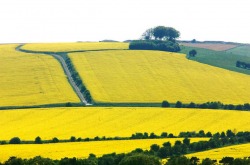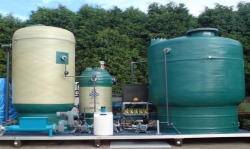Types of Biofuel
Bioethanol

Wheat Harvest
Bioethanol is a biologically produced biofuel that although being produced throughout the world is mainly produced in Brazil and the U.S.A.[1] The production of bioethanol takes a number of stages. First the biomass is anaerobically fermented[2] for a period of time allowing the break down of the sugar or starch contained in the plant material. However, a number of companies are now producing bioethanol by converting plant cellulose into sugars, allowing a wider range of biomass to be used. After fermenting the fuel must be distilled to allow the removal of water. However, this stage is gradually being replaced by dehydration as it produces better results using less energy, increasing the net energy gain of the fuel.
Biodiesel

Oilseed Rape
Biodiesel is produced from the fatty acids found in vegetable oils and is produced using a process known as transesterification[3], which involves using methanol to create a catalytic reaction. A number of biomass types can be used in the production of biodiesel such as rapeseed, sunflower and palm oil. Biodiesel is extremely versatile as it can be used in any diesel engine if it has been mixed with common diesel. However, many car manufactures are now designing cars so that they can run on 100% biodiesel. Another increasing popular section of biodiesel market is the re-use of vegetable oils used in the catering industry. The fast food chain McDonald's now converts its used cooking oil into biodiesel to power its fleet of delivery trucks.[4] The oil is filtered and pre-processed before being manufactured into biodiesel.
Biogas

Biogas Digesters
Biogas is produced during the anaerobic digestion of biomass [5] or during the gasification of wood using processes such as pyrolysis. Any type of organic biomass can be used to produce biogas as the material is simply biodegraded, during which the gas produced is siphoned off. Materials such as manure and sewage sludge can also be used in this process but their low biogas yield means they are an un-economical feedstock.[6] However, the production efficiency can be increased with the addition of energy crops and organic waste, which produce much higher yields and improves the net energy gain of the biogas.
Biobutanol

Biobutanol Potential
Biobutanol is produced in much the same way bioethanol, through the fermentation of starch. Butanol was once considered a by-product of the ABE fermentation process that was used extensively during the Second World War to produce acetone. The ABE process uses microbes, such as Clostridium acetobutylicum, to break down biomass producing Biobutanol.[6] In terms of feedstock, similar biomasses can be used in Biobutanol production as is used in the production of bioethanol. Biobutanol, like many other biofuels can be mixed with conventional fuels or can be used directly in engines.
Biohydrogen

Production Trial
Biohydrogen, like biogas, can be produced using a number of processes such as pyrolysis, gasification or biological fermentation.[6] Pyrolysis and gasification both heat biomass to produce the hydrogen while fermentation uses either dark fermentation or photofermentaion to produce hydrogen. Dark fermentation is an anaerobic process which through a series of biochemical reactions breaks down biomass using bacteria. Photofermentaion is similar to dark fermentation but it must have the presence of light for the reactions to take place. However, both processes have low efficiencies and therefore Biohydrogen production has not yet been attempted on a large scale.[7]
References
[1] Msangi S, Sulser T, Rosegrant M, Valmonte-Santos R, Ringler C (2006); Global Scenarios for Biofuels:
Impacts and Implications; International Food Policy Research Institute (IFPRI)
[2] Antoni D, Zverlov VV and Schwarz WH; Biofuels from microbes; Applied Microbiol Biotechnology 77:23–35 (2007)
[3] Stevens C. V., Verhe R. G. (2004); Renewable Bioresources: Scope and Modification for Non-Food Applications; John Wiley and Sons, Chichester, pg 229
[4] Our commitment to reducing waste: How we deak with used cooking oil; http://www.mcdonalds.co.uk/ourworld/environment/waste.shtml; 4/11/2009
[5] Stevens C. V., Verhe R. G. (2004); Renewable Bioresources: Scope and Modification for Non-Food Applications; John Wiley and Sons, Chichester, pg 108
[6] Antizar-Ladislao B., Turrion-Gomez J. L. (2008); Second-generation biofuels and local bioenergy systems; Biofuels, Bioproducts & Biorefining
[7] Sims R., Taylor M., Saddler J., Mabee W. (2008); From 1st- to 2nd- Generation Biofuel Technologies; International Energy Agency
[1] Msangi S, Sulser T, Rosegrant M, Valmonte-Santos R, Ringler C (2006); Global Scenarios for Biofuels:
Impacts and Implications; International Food Policy Research Institute (IFPRI)
[2] Antoni D, Zverlov VV and Schwarz WH; Biofuels from microbes; Applied Microbiol Biotechnology 77:23–35 (2007)
[3] Stevens C. V., Verhe R. G. (2004); Renewable Bioresources: Scope and Modification for Non-Food Applications; John Wiley and Sons, Chichester, pg 229
[4] Our commitment to reducing waste: How we deak with used cooking oil; http://www.mcdonalds.co.uk/ourworld/environment/waste.shtml; 4/11/2009
[5] Stevens C. V., Verhe R. G. (2004); Renewable Bioresources: Scope and Modification for Non-Food Applications; John Wiley and Sons, Chichester, pg 108
[6] Antizar-Ladislao B., Turrion-Gomez J. L. (2008); Second-generation biofuels and local bioenergy systems; Biofuels, Bioproducts & Biorefining
[7] Sims R., Taylor M., Saddler J., Mabee W. (2008); From 1st- to 2nd- Generation Biofuel Technologies; International Energy Agency
Picture of wheat harvest courtesy of http://www.farmersguardian.com/arable-focus-optimistic-signs-for-harvest/27300.article
Picture of oilseed rape courtesy of http://www.guardian.co.uk/environment/gallery/2008/apr/01/biofuels.forests?picture=333335751
Picture of biogas digester courtesy of http://www.moleculargate.com/biogas-digester-gas-purification/biogas-purification.html
Picture of biobutanol potential courtesy of http://www.bionomicfuel.com/biomass-fuel-biobutanol-as-direct-replacement-of-gasoline/
Picture of biohydrogen production trial courtesy of http://www.uk-shec.org.uk/uk-shec/research/uk-shec-2/theme1.html
Picture of oilseed rape courtesy of http://www.guardian.co.uk/environment/gallery/2008/apr/01/biofuels.forests?picture=333335751
Picture of biogas digester courtesy of http://www.moleculargate.com/biogas-digester-gas-purification/biogas-purification.html
Picture of biobutanol potential courtesy of http://www.bionomicfuel.com/biomass-fuel-biobutanol-as-direct-replacement-of-gasoline/
Picture of biohydrogen production trial courtesy of http://www.uk-shec.org.uk/uk-shec/research/uk-shec-2/theme1.html
